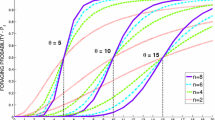Abstract
This paper presents a simple adaptation mechanism to automatically adjust the ratio of foragers to resters (division of labour) in a swarm of foraging robots and hence maximise the net energy income to the swarm. Three adaptation rules are introduced based on local sensing and communications. Individual robots use internal cues (successful food retrieval), environmental cues (collisions with teammates while searching for food) and social cues (teammate success in food retrieval) to dynamically vary the time spent foraging or resting. The paper investigates the effectiveness of a number of strategies based upon different combinations of cues, and demonstrates successful adaptive emergent division of labour. Strategies which employ the social cues are shown to lead to the fastest adaptation to changes in food density and we see that social cues have most impact when food density is low: robots need to cooperate more when energy is scarce.
Preview
Unable to display preview. Download preview PDF.
Similar content being viewed by others
References
Lerman, K.: Mathematical model of foraging in a group of robots: Effect of interference. Autonomous Robots 13(2), 127–141 (2002)
Krieger, M.J.B., Billeter, J.B.: The call of duty: Self-organised task allocation in a population of up to twelve mobile robots. Robotics and Autonomous Systems 30(1-2), 65–84 (2000)
Théraulaz, G., Bonabeau, E., Deneubourg, J.L.: Response threshold reinforcement and division of labour in insect societies. The Royal Society B: Biological Sciences 265, 327–332 (1998)
Labella, T.H., Dorigo, M., Deneubourg, J.L.: Efficiency and task allocation in prey retrieval. In: Proceedings of the First International Workshop on Biologically Inspired Approaches to Advanced Information Technology, vol. 3141, pp. 32–47 (2004)
Jones, C., Matarić, M.J.: Adaptive division of labor in large-scale multi-robot systems. In: IEEE/RSJ International Conference on Intelligent Robots and Systems (IROS), pp. 1969–1974. IEEE, Los Alamitos (2003)
Guerrero, J., Oliver, G.: Multi-robot task allocation strategies using auction-like mechanisms. In: Artificial Research and Development in Frontiers in Artificial Intelligence and Applications (2003)
Şahin, E.: Swarm robotics: From sources of inspiration to domains of appliction. In: Şahin, E., Spears, W.M. (eds.) Swarm Robotics. LNCS, vol. 3342, pp. 10–20. Springer, Heidelberg (2005)
Beni, G.: From swarm intelligence to swarm robotics. In: Şahin, E., Spears, W.M. (eds.) Swarm Robotics. LNCS, vol. 3342, pp. 1–9. Springer, Heidelberg (2005)
Camazine, S., Franks, N.R., Sneyd, J., Bonabeau, E., Deneubourg, J.L., Théraulaz, G.: Self-Organization in Biological Systems. Princeton University Press, Princeton (2001)
Martinoli, A., Easton, K.: Modeling swarm robotic systems. International Journal of Robotics Research 23(4), 415–436 (2004)
Gerkey, B.P., Vaughan, R.T., Howard, A.: The player/stage project: Tools for multi-robot and distributed sensor systems. In: Proceedings of the International Conference on Advanced Robotics, pp. 317–323 (2003)
Author information
Authors and Affiliations
Editor information
Rights and permissions
Copyright information
© 2007 Springer Berlin Heidelberg
About this paper
Cite this paper
Liu, W., Winfield, A., Sa, J., Chen, J., Dou, L. (2007). Strategies for Energy Optimisation in a Swarm of Foraging Robots. In: Şahin, E., Spears, W.M., Winfield, A.F.T. (eds) Swarm Robotics. SR 2006. Lecture Notes in Computer Science, vol 4433. Springer, Berlin, Heidelberg. https://doi.org/10.1007/978-3-540-71541-2_2
Download citation
DOI: https://doi.org/10.1007/978-3-540-71541-2_2
Publisher Name: Springer, Berlin, Heidelberg
Print ISBN: 978-3-540-71540-5
Online ISBN: 978-3-540-71541-2
eBook Packages: Computer ScienceComputer Science (R0)




